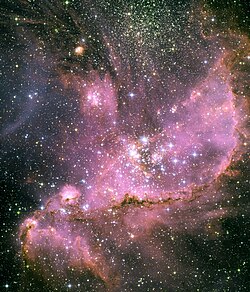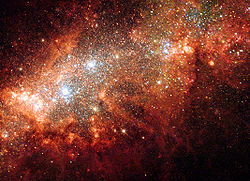A super star cluster (SSC) is a very massive young open cluster that is thought to be the precursor of a globular cluster. [1] These clusters called "super" because they are relatively more luminous and contain more mass than other young star clusters. [2] The SSC, however, does not have to physically be larger than other clusters of lower mass and luminosity. [3] They typically contain a very large number of young, massive stars that ionize a surrounding HII region or a so-called "Ultra dense HII region (UDHII)" in the Milky Way Galaxy [4] or in other galaxies (however, SSCs do not always have to be inside an HII region). An SSC's HII region is in turn surrounded by a cocoon of dust. In many cases, the stars and the HII regions will be invisible to observations in certain wavelengths of light, such as the visible spectrum, due to high levels of extinction. As a result, the youngest SSCs are best observed and photographed in radio and infrared. [5] SSCs, such as Westerlund 1 (Wd1), have been found in the Milky Way Galaxy. [6] However, most have been observed in farther regions of the universe. In the galaxy M82 alone, 197 young SSCs have been observed and identified using the Hubble Space Telescope. [7]
Contents
- Characteristics and properties
- Hubble Space Telescope contributions
- List of SSCs
- References
- External links

Generally, SSCs have been seen to form in the interactions between galaxies and in regions of high amounts of star formation with high enough pressures to satisfy the properties needed for the formation of a star cluster. [2] These regions can include newer galaxies with much new star formation, dwarf starburst galaxies, [8] arms of a spiral galaxy that have a high star formation rate, and in the merging of galaxies. In an Astronomical Journal published in 1996, using pictures taken in the ultraviolet (UV) spectrum by the Hubble Space Telescope of star-forming rings in five different barred galaxies, numerous star clusters were found in clumps within the rings which had high rates of star formation. These clusters were found to have masses of about 103 M☉ to 105 M☉, ages of about 100 Myr, and radii of about 5 pc, and are thought to evolve into globular clusters later in their lifetimes. [9] These properties match those found in SSCs.












